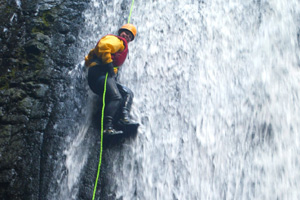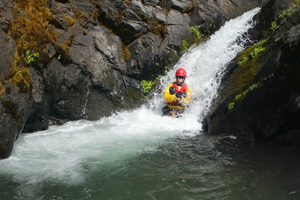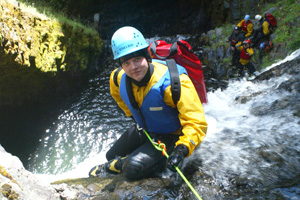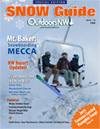Web Exclusive: Canyoneering Video

The Thrills and Chills of Canyoneering
Story and Photos by Michael Kundu
Photo at right: Nola Kundu descending a 40-foot waterfall.
Shrouded in a narrow, cubicle-sized alcove, the full force of the mountain stream swept past, the sound and force amplified in the granite bottleneck. Behind me, a moss-slick, 40-foot waterfall marked our route of entry into the chamber.
“Come on man, ride it all the way down,” prompted a voice behind me.
Tossing my pack directly into the middle of the current, I followed, foot-first, down a natural waterslide, and over a 10-foot drop, splashing into a deep, turquoise pool. Surfacing in the 43-degree glacial run off, I grabbed my pack from the backwash and clawed out to find myself in an even narrower rock chamber.
“Yeah!” I hollered. “I wanna do that again!”
Canyon Exploration
People have been exploring canyons across the world for thousands of years. Many ancient tribes lived and used deep canyon and cliff ecosystems for protection and sustenance, carving out a unique existence and culture in the geological rifts surrounding carved riverine valleys and hills.
In the United States, this type of cave exploration has emerged into a new technical sport called canyoneering, an off-shoot of sport climbing which uses equipment such as ascenders, static ropes and variable-speed rappel devices.
In the last two decades, canyoneering’s popularity has exploded. Today, emerging online communities across the world are providing evidence of a new subculture of enthusiasts willing to buy the needed gear and learn the technical skills required for the sport.
Canyoneering can best be described as a hybrid of rappelling, scrambling, river-boogie and cliff jumping, mostly conducted in geological drainages anyplace where moving water has carved a characteristic route from a higher to a lower elevation.
Initiates, outfitted with coldwater neoprene wetsuits (in wetter climates, most canyoneering sites originate from glacial or alpine watercourses), helmets for protection, traction-soled neoprene shoes, life jackets and waist harnesses, trace the route of a canyon or drainage downward, down-climbing, jumping, swimming, or rappelling through sections where the stream requires such actions.
One hell of a beating
“Considering that you’re often canyoneering in either glacially-cold rivers or arid desert environments, it’s often a sport of extremes,” says Christina Sears, who recently tried the sport for the first time near Bend, Ore. “It’s not generally a sport that you can try ‘just a little’—you need to be willing to get quite a bit outside your comfort zone and try things that most people would rationally avoid.”
Like rappelling over and through rushing waterfalls.
Using specialized static (minimally stretching) climbing ropes, many canyoneering routes (particularly those in the “wetter” regions in Washington, Oregon and British Columbia) involve descents over waterfalls ranging in height from 30 to 150 feet. Ropes are usually anchored to trees (using retrievable methods) near the top of the falls, and canyoneers descend the gradient either directly over, or adjacent to, the flow of water.
“The further you descend through a falls, the more powerful the force of the water pushing you downward,” says Sears. “At some point during the pummeling, you either reach bottom and have to disconnect from the rope while floating under the powerful falls, or swing your rappel sideways, out of the force of the drop.
“Either way, it’s one hell of a beating!”
Very technical skill requirements—like knowing how to rig a retrievable rope anchor, judge the depth of a pool drop before cliff-jumping, or how to safely control a rappel on a water-logged rope using traditional descending tools—require canyoneers to be properly trained in the sport before venturing out on their own.
“There’s a constant possibility of hypothermia, failing anchors—or even the prospect of rappelling into a canyon with no safe way to continue down a rapid or over a ledge,” adds Matt Moore, canyoneering guide and owner of Utah-based Desert Highlights Adventures. “In fact, having to ‘jug’ out (up-climbing a rope using technical ascenders) of a dead-end canyon is one of the most grueling challenges of the sport—you’d be wise to know how to use ascenders before you go out and explore a new canyon for the first time.”
Glacier water immersion sucks
 As with many other regional water sports, canyoneering in the Northwest also requires a thorough understanding of how to handle cold-water immersion.
As with many other regional water sports, canyoneering in the Northwest also requires a thorough understanding of how to handle cold-water immersion.
“Glacial run-off that generates many of the steep descents here in Oregon and Washington can range from just above freezing to almost 70 degrees in the summer,” adds Moore. “Some routes require constant immersion to navigate, and unless you’ve got the right gear, that could mean the difference between life
and death.”
That’s a statement not to be taken lightly.
On a recent descent off an isolated route in central Oregon, I stood waist deep in a small pool to give the rest of our group room to balance on a thin ledge, while rigging anchors for an impressive 50-meter rappel. Forty-five minutes later, when the ropes were adequately shielded (covered with a protective sheath to prevent abrasion) I was barely able to control my shaking to conduct the vertical drop.
Despite being garbed in 3mm neoprene and splash jacket, it took over 20 minutes of huddling with others in our group to restore my core temperature for the remainder of our descent through the gulley.
“In the Northwest, rushing glacial streams are constantly flushing away your body heat,” explains Moore. “Skull caps, neoprene gloves, booties and wetsuits are a bare minimum in this part of the country.”
An emerging sport
The recent movie, “127 Hours,” told the real-life saga of canyoneer Aron Ralston, who was trapped in a remote Utah canyon and forced to amputate his own hand. An Oscar nominee, the movie unsurprisingly increased the visibility of canyoneering and its risks.
Even advanced technological equipment may not be adequate to protect canyoneers from the dangers inherent in the activity. It is crucial to remember to file an accurate and specific trip plan with someone at home, and to ensure a copy of that plan (with a return date) is left at a trailhead.
As a still-emerging sport, authoritative canyoneering guidance and resources are still relatively sparse for those who might want to become self-taught in the activity. Interested beginners should hire a professional guide for their first venture—with aspirations of a 40-foot waterfall rappel in their future.
For more information about Northwest canyoneering, visit www.canyoneeringnorthwest.com
Michael Kundu is a Canadian communications professional and freelance adventure sports/environmental photojournalist. A board member of Project SeaWolf Coastal Protection and FarewellTravels.com, Michael is actively involved in kayaking, wildlife conservation, climbing, diving and other self-propelled outdoors sports. Michael, his two sons and wife Nola live in Lake Stevens, Wash.
Canyoneering Gear
Neoprene Wetsuit – at a minimum, a 3mm wetsuit, 2-piece (semi-dry recommended) with padded elbows and knees is recommended.
Splash Jacket – a durable splash jacket with neoprene seals at neck and wrist is recommended.
Neoprene Gloves and Socks and skullcap – 2mm to 5mm socks, 2mm gloves will still allow you to work the ropes and rappel hardware.
Helmet – don’t even think about canyoneering without one.
Seat Harness – a robust harness with large-width leg straps and stainless buckles.
11mm Static Climbing Rope and 30 meters of webbing – for rappels and anchor rigging. Please note that traditional dynamic climbing rope is not suitable for canyoneering.
Rappel Device and Locking Carabiners – a specialized descending device like Petzl’s Pirana or Omega Pacific SBG II are recommended. Locking caribiners should have screw-gates and be completely smooth.
Friction-soled Canyoneering Boots – neoprene with sturdy sole and suitable for footing in wet or submerged environments.
Ascenders and/or Prussiks – at least two devices or dedicated prussiks that can be used to climb out of a hole if necessary.
Watertight Backpack or Drybags – for keeping extra gear and emergency gear dry and floating on your descent.
Safety Gear – GPS, whistles to signal others above the din of rapids or waterfall, knife, first-aid kit and an appropriate signal device (EPIRB, PLB or SPOT, etc.).





Mike Mcquilla, 6 months ago
Hehehe. Love seeing your pics and comments. Im from AZ and spend almost every weekend in the canyons down here. From central AZ to the Grand canyon to southern Utah. Id love to get my team up there to do a few of your canyons. Any one interested in chatting with me about hosting a weekend up there for a weekend down here.
I can be found as Sneak route on face book